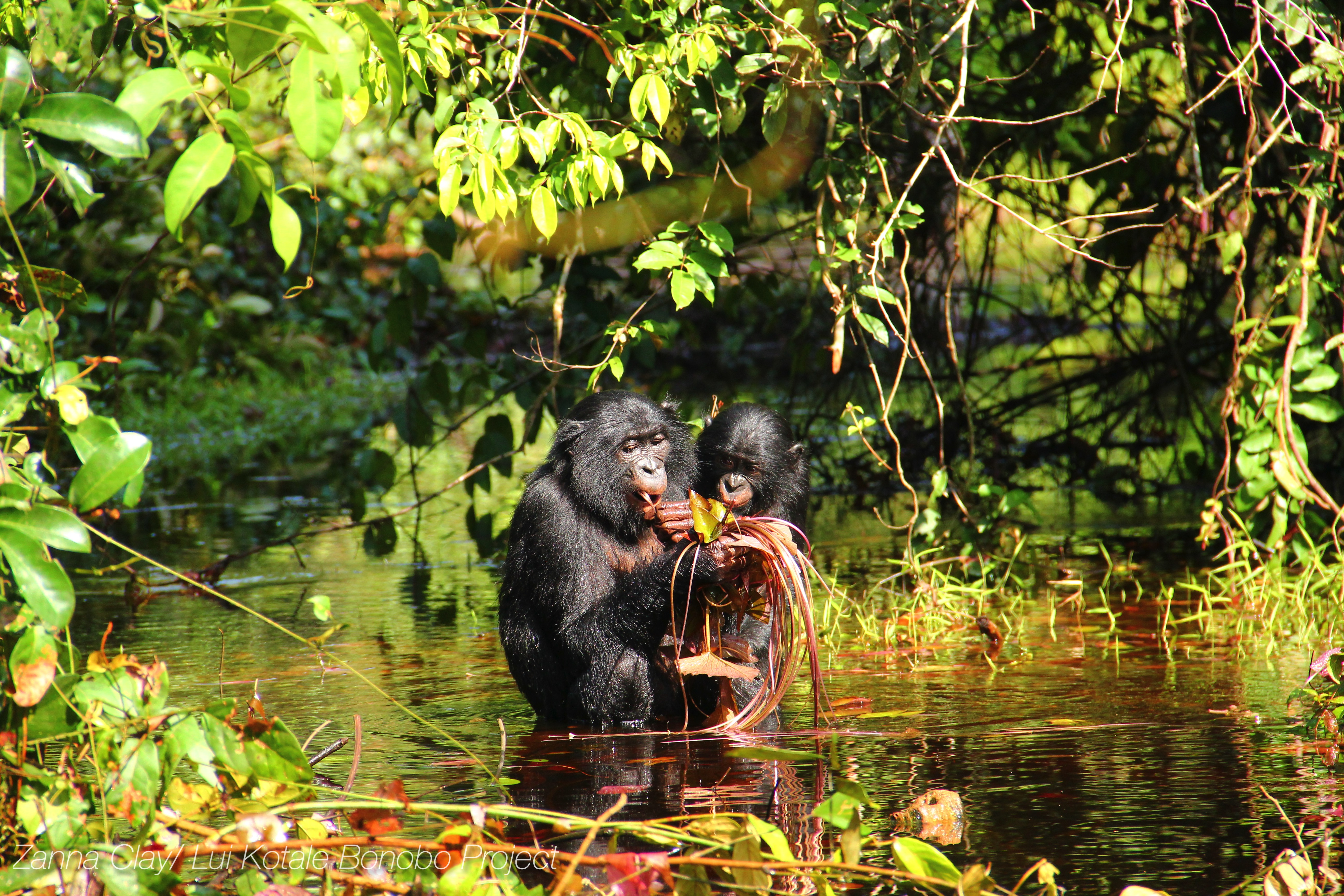Bonobo communication reveals fascinating insights into the complex social interactions of these remarkable primates. Recent studies highlight how bonobos utilize vocalizations much like humans, employing a range of calls to convey intricate information about their environment and social structure. This emerging understanding of bonobo vocalizations illuminates the evolutionary roots of language, suggesting that the ability to form compound phrases may date back well before human origins. Researchers have discovered a significant degree of compositionality in bonobo calls, indicating that these magnificent animals can combine sounds in ways that express nuanced ideas, reflecting their social bonding dynamics. By examining how bonobos communicate, we gain not only a deeper appreciation for their social lives but also a broader understanding of animal communication and the evolution of language itself.
The study of bonobo vocal interactions sheds light on the sophisticated mechanisms underlying animal dialogue. These intelligent apes, closely related to humans, demonstrate remarkable vocal behavior that can reveal their emotional states and social dynamics. Researchers have identified specific sound combinations that function much like human phrases, allowing bonobos to navigate their social landscape effectively. Understanding these calls provides a glimpse into the evolution of linguistic capabilities and the intricate social bonds that characterize bonobo communities. As scientists explore the depths of bonobo communication, they also unearth fundamental principles of language evolution and the shared traits between us and our primate relatives.
Understanding Bonobo Communication: A New Perspective
The study of bonobo communication has unveiled fascinating parallels to human language, enriching our understanding of how complex social interactions are navigated among these primates. Research indicates that bonobos utilize a sophisticated system of vocalizations, often reflecting equivalent structures found in human language. For instance, vocalizations such as whistles or peeps can be utilized to convey urgent social messages, effectively coordinating group movements and signaling social tensions. This replaces simplistic communication with a complex lexicon that mirrors the essence of human linguistic structures.
By analyzing the vocal habits of bonobos in their natural habitat, researchers have revealed that these animals engage in compositionality, a linguistic feature where meanings are derived not just from individual calls, but through the combination of sounds and sequences. This finding is significant because it implies that the foundations of communication, much like those seen in humans, may have deeper evolutionary roots than previously thought. Understanding bonobo communication allows us to reflect on the evolution of human language and the potential shared traits between species.
The Role of Vocalizations in Bonobo Social Bonds
Bonobos are well-known for their complex social structures and strong bonds within their groups. Vocalizations play an essential role in maintaining these relationships, acting as a means of expression that facilitates social interaction. Through specific calls, bonobos can signal intentions or emotional states, which helps to reinforce social ties and enables them to navigate their intricate social hierarchy. The ability to communicate nuanced emotions and intentions through vocalizations enhances their societal cohesion, which is vital for their survival.
Research has demonstrated that vocalizations can preemptively warn others of threats or guide group members towards food sources, suggesting that these calls serve as tools for social navigation. The significance of vocalizations in bonobos extends beyond mere communication; it reflects the intricate dynamics of their social relationships. As the vocal repertoire of bonobos is systematically cataloged, it becomes clear that these animals possess a unique articulation of social bonding that highlights their cognitive abilities.
The Evolutionary Significance of Bonobo Vocalizations
The evolutionary journey of communication has been a focal point of research, particularly as scientists strive to understand how language emerged among primates. Bonobos, sharing a common ancestor with humans, offer valuable insights into this ancient evolutionary path. The study of their vocalizations reveals that the development of complex communication systems may have originated far earlier than previously believed, possibly predating the emergence of modern humans. This prompts further examination of how social complexity influences communication capabilities in species.
Bonobos also exemplify how linguistic traits can emerge from their social environments. Their expressive vocalizations showcase a level of combinatorial complexity that aligns closely with early forms of human language. This suggests that social bonding in bonobos might have catalyzed the evolution of communication, emphasizing the interconnectedness of social structures and language development. As researchers delve deeper into the vocal habits of bonobos, we can gain a clearer picture of the evolutionary steps that led to human-like communication.
Compositionality in Bonobo Vocal Communication
Compositionality, the ability to combine call elements to create new meanings, defines much of what makes human language unique. Recent findings highlight that bonobos exhibit similar characteristics in their vocal communication. Researchers have documented series of calls that not only serve immediate social functions but can also be combined to produce more intricate meanings, reflecting a form of language adaptability that has not been extensively documented outside human contexts. This discovery underscores the cognitive sophistication of bonobos and invites comparisons with human linguistic abilities.
By analyzing the specific contexts in which different vocalizations occur, researchers are beginning to construct a ‘dictionary’ of bonobo calls, illustrating how combinations of vocalizations can indicate diverse scenarios ranging from alerting to danger to expressing affection. This form of compositionality symbolizes a significant step in understanding animal communication, suggesting that the cognitive foundations for language may not be exclusively human. Such insights provide a richer context for our understanding of language evolution and the cognitive parallels between bonobos and humans.
Analyzing Bonobo Vocalizations Across Contexts
The meticulous research conducted on the vocal behavior of bonobos sheds light on how context influences vocal expression. Each recorded vocalization corresponds to specific scenarios, enhancing our understanding of their communicative intents. For example, a peep followed by a whistle could indicate an urgent warning among bonobos, with different calls implying varying degrees of social tension or the need for cooperation in group movements. Such specificity in vocalizations reveals the depth of bonobo communication.
By assessing vocal patterns across diverse contexts, researchers are beginning to appreciate the dynamic nature of bonobo interactions. The intricate web of meanings derived from their vocal repertoire indicates not only their need to adapt to social challenges but also highlights the underlying significance of social bonding in maintaining group cohesion. This understanding poses exciting questions about the potential for non-human species to develop communication systems that are more complex than previously recognized.
Bonobos versus Other Primate Communication
Comparing bonobo vocalizations with those of other primates, such as chimpanzees, reveals distinctive features that may reflect their differing social structures. While both species display vocal complexity, the degree of compositionality appears markedly higher in bonobos, suggesting that their social lives necessitate more intricate communication methods. Bonobos’ matriarchal societies may also contribute to their advanced vocal behavior, as maintaining social bonds among females is crucial for group stability and harmony.
Previous studies on chimpanzee communication have primarily focused on isolated vocal calls. In contrast, the recent research on bonobos emphasizes the importance of understanding their entire vocal repertoire in terms of social context and sequencing. This shift in perspective not only enriches our comprehension of bonobo vocalizations, but also sets the stage for deeper investigations into the evolution of language among primates, encouraging a broader exploration of how social frameworks inform communication capabilities.
Bonobo Communication and Language Development
The exploration of bonobo communication reaches into the realms of language development and cognitive science. As bonobos utilize complex vocalizations that appear to have syntactical structures, they offer a unique glimpse into the early stages of language evolution. The methodologies used to study their vocal combinations may inspire new avenues of research into the cognitive abilities of other species, particularly those closely related to humans. This examination highlights the significance of social interaction in the emergence of sophisticated communication systems.
Moreover, understanding how bonobos employ vocalizations may help illuminate the cognitive processes behind language learning in both animals and humans. By observing how bonobos learn to combine sounds in meaningful ways, researchers can better grasp the mechanisms that undergird the development of language in primate evolution. This ongoing research underscores the interconnectedness between social relationships and communication, emphasizing that the ability to convey complex ideas likely played a role in shaping the linguistic capabilities of early humans.
The Impact of Environmental Factors on Bonobo Vocalizations
Environmental factors play a crucial role in shaping the vocal communications of bonobos. Living in dense forests where visibility is often limited, bonobos have developed auditory cues that facilitate group cohesion over long distances. This adaptation underscores the significance of vocalizations as an essential tool for survival, ensuring that group members can remain connected despite physical barriers. The study of bonobo calls in various environmental contexts highlights how vocal communication evolves in response to specific ecological challenges.
Furthermore, the impact of habitat and social dynamics on bonobo vocalization offers insights into how other species might adapt their communications to similar environmental pressures. By analyzing how bonobos modify their call patterns in different situations, researchers aim to gain a comprehensive understanding of the interplay between environmental factors and communication strategies. This exploration will continue to expand the body of knowledge surrounding animal communication, suggesting that vocal flexibility may be a common trait among social species adapting to their environments.
The Future of Bonobo Communication Research
The ongoing research into bonobo communication opens up new avenues for understanding animal languages and their implications for evolutionary biology. As researchers compile and analyze more data on bonobo vocalizations, we can expect to see advancements in how we conceptualize communication systems beyond human language. This evolving field can lead to breakthroughs in understanding not only the cognitive abilities of bonobos but those of other animal species, ultimately contributing to a greater comprehension of the evolution of communication.
In the future, integrating technological advancements in audio analysis and machine learning might further enhance the study of bonobo vocalizations. These tools can aid in identifying patterns within vast datasets, offering a more nuanced understanding of the meanings behind their calls. As we continue to deepen our understanding of bonobo communication, it might also provide insights into our own linguistic development, highlighting the intricate connections between species and the evolutionary journey of language.
Frequently Asked Questions
What are bonobo vocalizations and how do they contribute to animal communication?
Bonobo vocalizations refer to the various sounds made by bonobos to convey messages and information within their social groups. These vocalizations, such as peeps, yelps, and whistles, are crucial for animal communication as they help coordinate group movements and signal emotional states. Research has shown that bonobos use these sounds with a level of compositionality similar to human language, allowing them to express complex social situations.
How do bonobos exhibit language evolution through their vocal behaviors?
Bonobos demonstrate language evolution through their sophisticated vocal behaviors. Studies indicate that they utilize word compounds and specific phrasings, suggesting advanced communication skills that may predate human origins. Their ability to form complex vocal expressions indicates an evolutionary path towards more intricate language systems, highlighting the importance of social bonding in the development of communication.
What role does compositionality play in bonobo communication?
Compositionality plays a significant role in bonobo communication as it allows them to create and combine vocalizations to express more complex messages. This means that individual sounds can be combined to convey specific meanings or emotional states, similar to how humans construct phrases. This capability enhances their social interactions and reflects a deeper evolutionary link between bonobos and human language.
How does social bonding in bonobos relate to their communication systems?
Social bonding in bonobos is intricately linked to their communication systems. The complexity of bonobo social structures drives the need for nuanced vocal exchanges, enabling them to maintain relationships across distances. Their vocalizations facilitate group cohesion, help navigate social tensions, and strengthen bonds, illustrating how animal communication evolves in tandem with social dynamics.
Can bonobo vocalizations be systematically analyzed like human language?
Yes, bonobo vocalizations can be systematically analyzed similarly to human language. Recent research has created a ‘dictionary’ of bonobo vocal sounds, providing insights into their meanings and contextual use. This systematic approach allows researchers to observe how various vocalizations correlate with specific actions, enhancing our understanding of animal communication and its complexities.
What findings have researchers discovered about vocal complexity in bonobos?
Researchers have found that bonobos exhibit remarkable vocal complexity, with their sounds reflecting social situations and emotional states. This complexity is aligned with their sophisticated social structures, suggesting that as bonobos maintain intricate social relationships, their communication systems have also evolved to become more advanced, resembling aspects of human language.
Are bonobos the only species with complex communication systems?
No, while bonobos display complex communication systems, they are not the only species to do so. Similar patterns of vocalization have been observed in chimpanzees, though research into bonobos has provided a more comprehensive understanding of animal communication. Both species demonstrate how social complexity can drive the evolution of intricate communication methods.
How does this research on bonobo communication impact our understanding of human language development?
The research on bonobo communication has significant implications for understanding human language development. By examining the compositionality and contextual use of bonobo vocalizations, scientists can gain insights into the evolutionary origins of language, suggesting that many linguistic traits may have been shared between our common ancestors and bonobos.
| Key Point | Details |
|---|---|
| Bonobo Vocalization | Bonobos vocalize to communicate with distant group members, indicating complex social interactions. |
| Research Findings | A study reveals that bonobos use word compounds and phrasings, suggesting that the roots of language predate human origins. |
| Compositionality | Bonobos exhibit a communication style that allows for the creation of new meanings from the combination of vocalizations, analogous to human language. |
| Social Complexity | Bonobo communication is linked to their complex social organization, enabling coordinated group movements and management of social bonds. |
| Dictionary of Vocalizations | Researchers compiled a dictionary capturing the meanings of various bonobo vocalizations and their combinations, marking a significant advance in understanding animal communication. |
| Implications for Understanding Language Evolution | The findings suggest that aspects of language, such as compositionality, may be shared between humans and other primates, reshaping notions of language origins. |
Summary
Bonobo communication reveals significant insights into the evolution of language patterns shared between humans and our closest living relatives, the bonobos. This fascinating research uncovers that bonobos employ vocalizations analogous to word compounds, demonstrating sophisticated communication that suggests the roots of language could predate human development. Such findings not only enhance our understanding of bonobo social structures and their intricate interactions but also provide critical context in exploring the evolution of human language.










